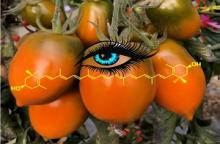- About us
- Research
- Students & Teaching
- Seminars & Events
- Directories
- Booking Rooms & Equipment
- עברית
Home » A new strain of tomatoes serving as a source of antioxidant ziaxanthin was developed in Prof. Hirschberg's lab
The oxygenated carotenoid zeaxanthin provides numerous benefits to human health due to its antioxidant properties. Especially it is linked to protecting, together with the xanthophyll lutein, the retina in the human eye by filtering harmful blue light thus delaying the progression of age‐related macular degeneration (AMD), the most prevalent cause of blindness in developed countries. Despite its high nutritional value, zeaxanthin is less available than other substantial carotenoids in our diet.
To solve this shortage, we chose to develop a new food source that would contain a high concentration of natural zeaxanthin. Tomato (Solanum lycopersicum L.) was selected as the target plant since it is the second largest vegetable crop grown worldwide and its fruit characteristically synthesizes and accumulates a high concentration of carotenoids.
We employed two genetic approaches in order to enhance zeaxanthin biosynthesis in tomato fruit: a transgenic metabolic engineering and classical genetic breeding. A nontransgenic tomato line, named ‘Xantomato’, was generated whose fruit accumulated zeaxanthin at a concentration of 39 μg/g fresh weight (or 577 μg/g dry weight), which comprised ca. 50% of total fruit carotenoids compared to zero in the wild type. This is the highest concentration of zeaxanthin reached in a primary crop.
Xantomato can potentially increase zeaxanthin availability in the human diet and serve as raw material for industrial applications.
